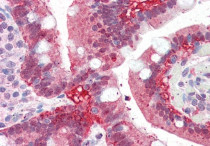ARG63695
anti-AKR1C3 antibody
anti-AKR1C3 antibody for IHC-Formalin-fixed paraffin-embedded sections,Western blot and Human
Metabolism antibody; Neuroscience antibody; Signaling Transduction antibody
Overview
| Product Description | Goat Polyclonal antibody recognizes AKR1C3 |
|---|---|
| Tested Reactivity | Hu |
| Tested Application | IHC-P, WB |
| Host | Goat |
| Clonality | Polyclonal |
| Isotype | IgG |
| Target Name | AKR1C3 |
| Antigen Species | Human |
| Immunogen | CFASHPNYPYSDEY |
| Conjugation | Un-conjugated |
| Alternate Names | Trans-1,2-dihydrobenzene-1,2-diol dehydrogenase; Testosterone 17-beta-dehydrogenase 5; EC 1.1.1.239; Dihydrodiol dehydrogenase 3; HA1753; EC 1.1.1.112; 3-alpha-HSD type II, brain; Chlordecone reductase homolog HAKRb; DD3; Indanol dehydrogenase; EC 1.1.1.188; HSD17B5; Aldo-keto reductase family 1 member C3; DDX; 17-beta-hydroxysteroid dehydrogenase type 5; hluPGFS; 3-alpha-HSD type 2; EC 1.3.1.20; EC 1.1.1.357; Prostaglandin F synthase; HAKRe; 3-alpha-hydroxysteroid dehydrogenase type 2; EC 1.1.1.64; DD-3; 17-beta-HSD 5; HAKRB; EC 1.-.-.-; Dihydrodiol dehydrogenase type I; PGFS |
Application Instructions
| Application Suggestion |
|
||||||
|---|---|---|---|---|---|---|---|
| Application Note | WB: Recommend incubate at RT for 1h. IHC-P: Antigen Retrieval: Steam tissue section in Citrate buffer (pH 6.0). * The dilutions indicate recommended starting dilutions and the optimal dilutions or concentrations should be determined by the scientist. |
Properties
| Form | Liquid |
|---|---|
| Purification | Purified from goat serum by antigen affinity chromatography. |
| Buffer | Tris saline (pH 7.3), 0.02% Sodium azide and 0.5% BSA. |
| Preservative | 0.02% Sodium azide |
| Stabilizer | 0.5% BSA |
| Concentration | 0.5 mg/ml |
| Storage Instruction | For continuous use, store undiluted antibody at 2-8°C for up to a week. For long-term storage, aliquot and store at -20°C or below. Storage in frost free freezers is not recommended. Avoid repeated freeze/thaw cycles. Suggest spin the vial prior to opening. The antibody solution should be gently mixed before use. |
| Note | For laboratory research only, not for drug, diagnostic or other use. |
Bioinformation
| Database Links |
Swiss-port # P42330 Human Aldo-keto reductase family 1 member C3 |
|---|---|
| Background | This gene encodes a member of the aldo/keto reductase superfamily, which consists of more than 40 known enzymes and proteins. These enzymes catalyze the conversion of aldehydes and ketones to their corresponding alcohols by utilizing NADH and/or NADPH as cofactors. The enzymes display overlapping but distinct substrate specificity. This enzyme catalyzes the reduction of prostaglandin (PG) D2, PGH2 and phenanthrenequinone (PQ), and the oxidation of 9alpha,11beta-PGF2 to PGD2. It may play an important role in the pathogenesis of allergic diseases such as asthma, and may also have a role in controlling cell growth and/or differentiation. This gene shares high sequence identity with three other gene members and is clustered with those three genes at chromosome 10p15-p14. Three transcript variants encoding different isoforms have been found for this gene. [provided by RefSeq, Dec 2011] |
| Research Area | Metabolism antibody; Neuroscience antibody; Signaling Transduction antibody |
| Calculated MW | 37 kDa |
Images (2) Click the Picture to Zoom In
-
ARG63695 anti-AKR1C3 antibody WB image
Western Blot: human breast lysate (35 µg protein in RIPA buffer) stained with ARG63695 anti-AKR1C3 antibody at 0.03 µg/ml dilution.
-
ARG63695 anti-AKR1C3 antibody IHC-P image
Immunohistochemistry: Paraffin-embedded Human small intestine tissue. Antigen Retrieval: Steam tissue section in Citrate buffer (pH 6.0). The tissue section was stained with ARG63695 anti-AKR1C3 antibody at 5 µg/ml dilution followed by AP-staining.







